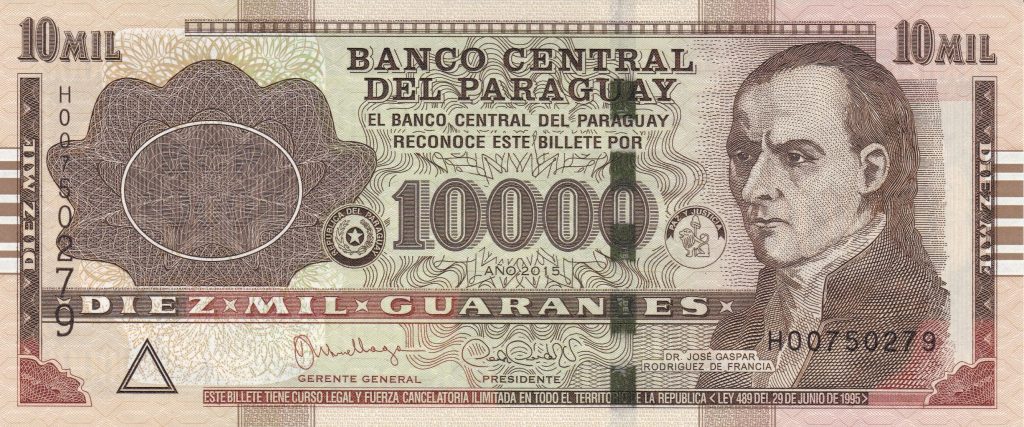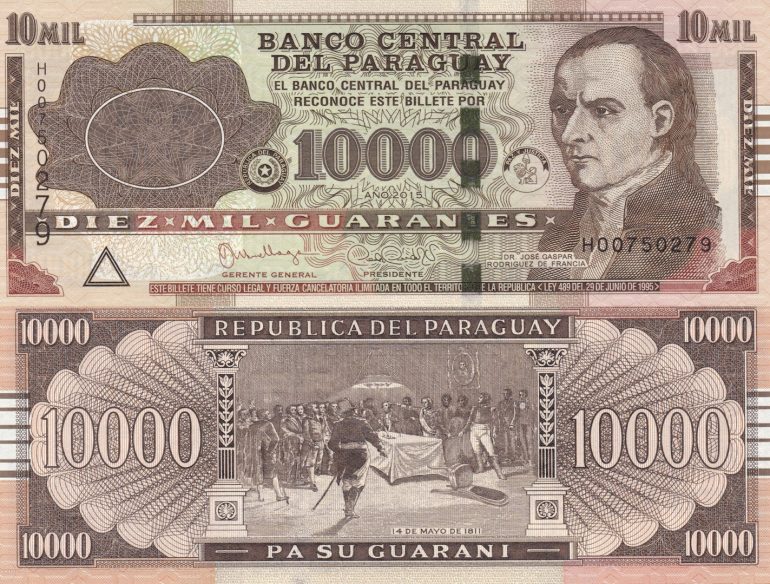Paraguay’s currency tells a story beyond its value. In the weekly series “Money Talks”, The Asunción Times takes readers on a journey through the nation’s banknotes. Each edition will explore a different bill, revealing the history, culture, and notable figures depicted on it. The series will also highlight the hidden details that make each note unique. From pioneers of education to national symbols, this series uncovers the stories woven into Paraguay’s money. This week: The story about the 10,000 Guaraní note’s disputed iconographic mistake.
After the article about the hidden details on the Gs. 5,000 bankote, we zoom in on the next note in line: For over sixty years, the Gs. 10,000 banknote has carried a celebrated scene of independence, yet historians argue it depicts the wrong revolution. In 2012, Paraguayan President Federico Franco vowed to correct the enigma, only for the flawed masterpiece to outlast his term.
Honouring Dr. José Gaspar Rodríguez de Francia
But first, the Gs. 10,000 note honours Dr. José Gaspar Rodríguez de Francia, an important figure in Paraguayan politics. He was a central figure in Paraguay’s independence and ruled the country in an authoritarian way between 1813 and 1840. This earned Rodríguez de Francia the nickname “The Supreme Dictator.” His image remains on the banknote to commemorate his role in the formation of the nation and the consolidation of its sovereignty.
On the left corner, you have a latent image. If you look closely, they can see the letters BCP. The letters stand for “Banco Central de Paraguay: Central Bank of Paraguay. On both sides of the 10,000 note, you can see two seals. The one of the left represents the Official Seal of the Republic of Paraguay. On the right, there is one representing peace and justice.

The “Velasco Intimation” and an iconographic mistake
The “Velasco Intimation” (Intimación al gobernador Velasco) image on the back of the Gs. 10,000 banknote refers to a note sent on 14 May 1811 by Paraguayan revolutionaries, led by Pedro Juan Caballero, during Paraguay’s independence. The note was addressed to the Spanish Governor Bernardo de Velasco, demanding his surrender and the transfer of power. This marked the start of the May Revolution, leading to Paraguay’s independence and the establishment of its first independent government.
The actual scene of this iconic moment in Paraguayan independence (indicated by the date “14 de Mayo de 1811” added to the image) is printed on the reverse of the banknote, but it may very well not be that specific moment in time. Historians suspect an iconographic error. They argue that the image depicted is “The Summons to Cisneros”, and these historians believe it actually represents the intimation in Buenos Aires to the then Viceroy of the Río de la Plata, Baltasar Hidalgo de Cisneros y de la Torre, on the night of 24 May 1810; different revolution, different city, and almost a year earlier!

How did the error appear on the banknote?
The work depicted on the Gs. 10,000 note was originally a painting. The artwork was commissioned by the Government of Argentina from the Italian artist Guillermo Da Ré to commemorate the country’s centennial of independence in 1910. However, following a change of government, the work was rejected by the then President Hipólito Yrigoyen. The painting was subsequently sold to the Paraguayan Juan Silvano Godoy under the title “Sign of Summons to Velasco”.
At present, it is not entirely clear how it came about, but the painting was adopted as a representative image of Paraguayan independence. The image has been printed on the Gs. 10,000 banknote since 1963, and was never changed.
Although, an effort was made.
Attempted change
During his administration, Paraguayan President Federico Franco (2012–2013) attempted to replace this iconographic error. Franco targeted the “Velasco Intimation” painting, calling it historically inaccurate. He argued it actually depicts the Argentine Revolución de Mayo (24 May 1810) to Viceroy Baltasar Hidalgo de Cisneros.
But no change was implemented: Franco’s term ended in August 2013 (elected Horacio Cartes took over), and the Central Bank of Paraguay never redesigned. Changes were possibly costly, and politically risky, due to the painting being a national symbol. Any change to the image must be approved by Congress, which can make the process complicated. To this day, the assumed iconographic mistake remains.


